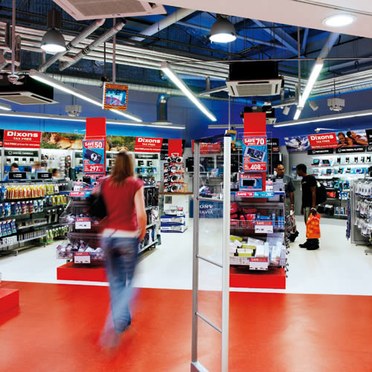Dixons Retail, Birmingham
- Lamp efficacy
Lamp efficacy
Ensuring the lamp efficiently converts electricity into light (lm/W).
- Ballast classification
Ballast classification
Controlling the electricity supply to the lamp (Energy Efficiency Index).
- Luminaire distribution
Luminaire distribution
Controlling light emission using optics which bend and shape the light to the correct location.
- System efficacy
System efficacy
Combining optical and thermal control within the luminaire (luminaire lm/W).
- Presence/absence detection
Presence/absence detection
Presence: Lights automatically turn on/off with movement. Absence: Lights automatically turn off and must be manually switched on.
- Daylight detection
Daylight detection
Artificial lighting which responds to the natural light conditions.
- Constant illuminance
Constant illuminance
A function designed to produce correct light levels for the duration of the maintenance period.
- Task-scene setting
Task-scene setting
Allowing the user to set scenes and adapt the lighting to different tasks.
- Timed off
Timed off
Automatic cut-off can be installed to turn all lights off during unoccupied hours.
- Task lighting
Task lighting
Lighting task areas with the correct amount of light.
- Zoning of lighting
Zoning of lighting
Lighting is zoned according to area use.
- Maintenance schedule
Maintenance schedule
Maintenance must be performed in response to product age, performance and environment.
- Waste light
Waste light
Eliminating waste light which does not hit the intended target.
- Reflectance
Reflectance
Taking advantage of light which is reflected from the surface within the space.
- Visible smart metering
Visible smart metering
Results of actions can be quickly seen as increased or decreased energy use to encourage responsible energy consumption.
Selling in a better light
The renovation of Dixon’s at Birmingham Airport, UK is a marvellous example of retail lighting at its best, and uses some of the most up-to-date luminaires. Renovation of Dixon’s tax-free electronics store - with its strong focus on digital technology - sets new standards of energy efficiency.
Powerful Concavia S pendants (which house 150W metal halide lamps) provide the primary light source. They keep ambient lighting relatively low so that alternative light sources providing supplementary lighting can be used to greatest effect.
For example, Primata prewired trunking has been used to light the aisles and draw attention to the store’s merchandise. Just as a verbal language is used to build sentences and paragraphs, we experience lit environments as a sequence of visual impressions.
Dixon’s have visualised space in three dimensions, and orchestrated the lighting in a planned sequence: the linear fluorescents speak of direction, leading the eye and the footstep.
The overall effect is very impressive with an extremely pleasant environment in which to shop and work.

